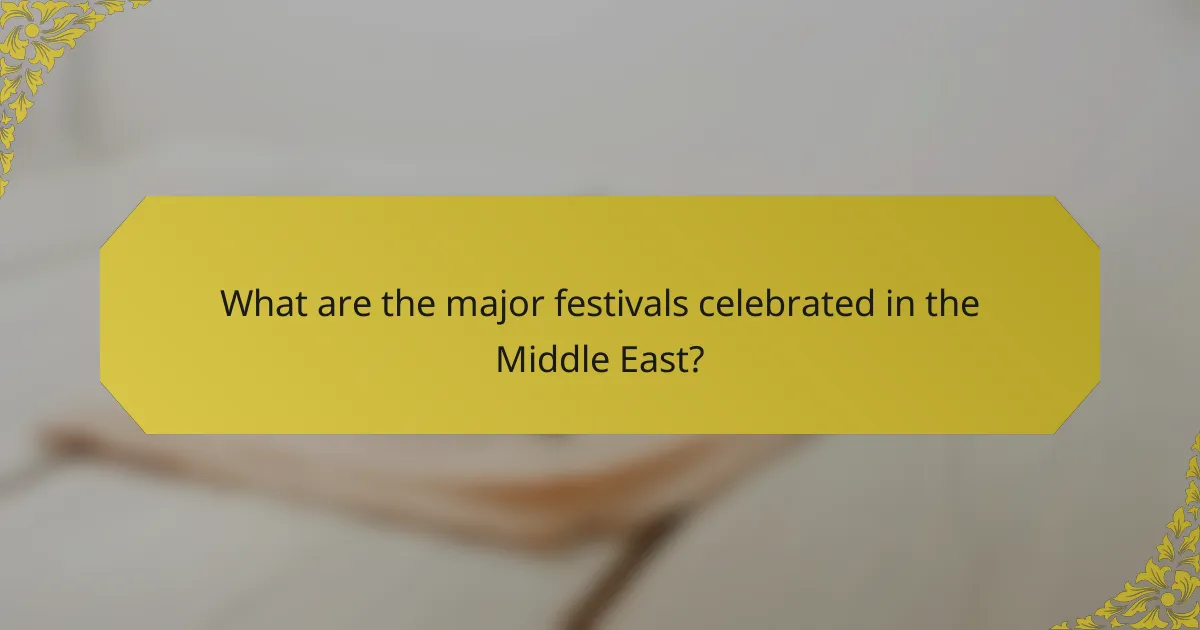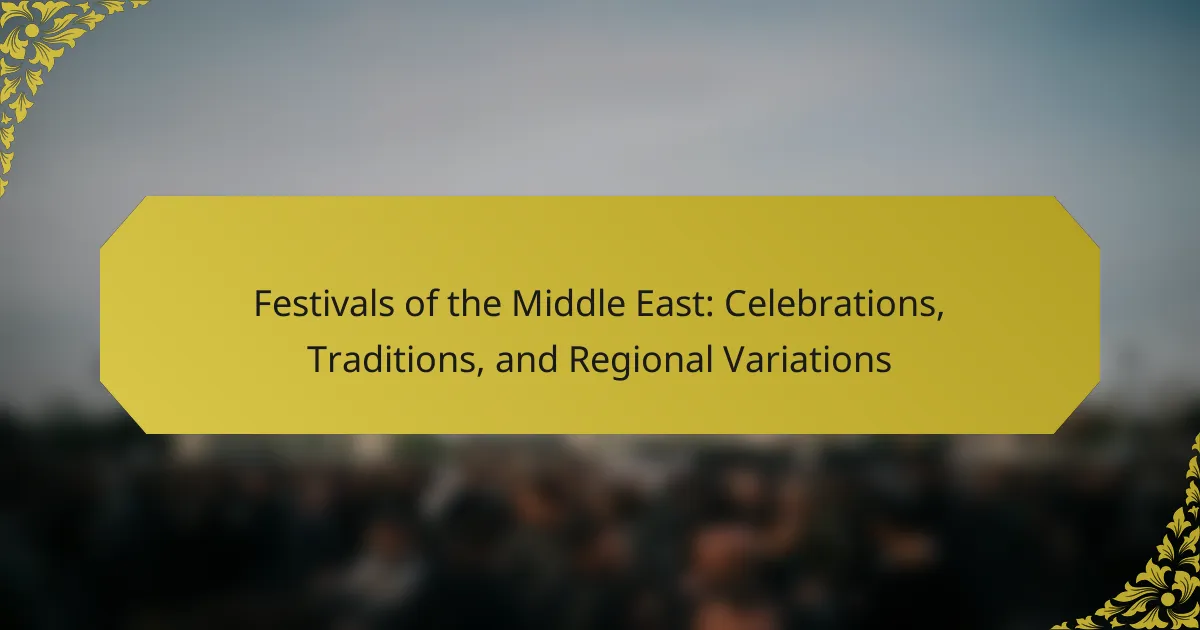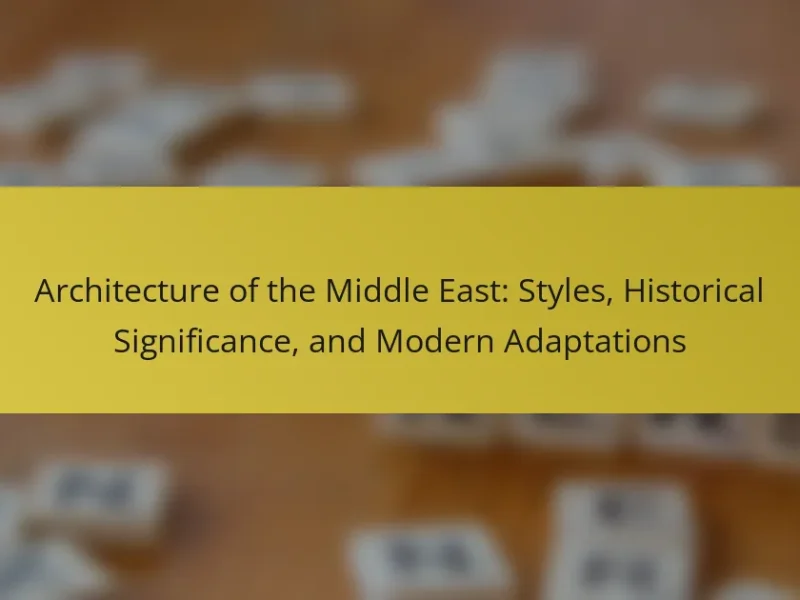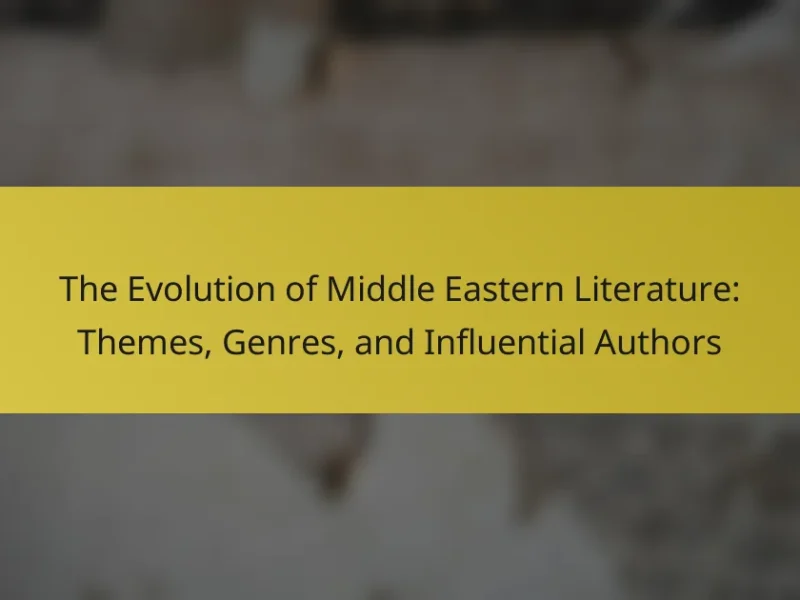
What are the major festivals celebrated in the Middle East?
The major festivals celebrated in the Middle East include Eid al-Fitr, Eid al-Adha, and Nowruz. Eid al-Fitr marks the end of Ramadan, the holy month of fasting. It is celebrated with prayers, feasting, and giving to charity. Eid al-Adha commemorates the willingness of Ibrahim to sacrifice his son. It involves the ritual sacrifice of animals and communal prayers. Nowruz, the Persian New Year, celebrates the arrival of spring. It is observed with various cultural traditions, including family gatherings and special meals. These festivals reflect the region’s rich cultural and religious diversity.
How do cultural and religious backgrounds influence these festivals?
Cultural and religious backgrounds significantly shape the festivals in the Middle East. Each festival reflects the traditions, beliefs, and values of the communities celebrating them. For instance, Islamic holidays like Eid al-Fitr and Eid al-Adha are rooted in religious teachings and practices. These festivals emphasize community, charity, and gratitude.
In contrast, cultural festivals such as Nowruz celebrate the Persian New Year and highlight themes of renewal and nature. Historical influences also play a role. Festivals may incorporate ancient customs, regional folklore, and local cuisine. The diversity of ethnic groups in the Middle East results in unique variations of celebrations even within the same religious framework.
Specific practices, such as communal prayers or feasting, often vary between different sects and ethnicities. For example, Shia and Sunni Muslims may observe certain holidays with distinct rituals. Additionally, festivals can serve as a means of cultural preservation, reinforcing identity among communities. Overall, cultural and religious backgrounds intertwine to create a rich tapestry of festivals in the Middle East.
What are the key religious festivals in the Middle East?
Key religious festivals in the Middle East include Eid al-Fitr, Eid al-Adha, and Ramadan. Eid al-Fitr marks the end of Ramadan, a month of fasting observed by Muslims. Eid al-Adha commemorates the willingness of Ibrahim to sacrifice his son as an act of obedience to God. Ramadan is significant for its emphasis on fasting, prayer, and reflection. Other important festivals include Nowruz, celebrated by various cultures, marking the Persian New Year. These festivals are characterized by communal prayers, feasting, and various cultural traditions. Each festival reflects the rich religious and cultural diversity of the region.
How do secular festivals differ from religious celebrations?
Secular festivals differ from religious celebrations primarily in their focus and purpose. Secular festivals celebrate cultural, historical, or seasonal events. They do not have religious significance or rituals associated with them. Examples include national holidays like Independence Day or cultural events like music festivals. In contrast, religious celebrations are rooted in spiritual beliefs and practices. They often commemorate significant religious events or figures, such as Christmas or Ramadan. Religious celebrations typically involve rituals, prayers, and community gatherings. The distinction lies in the absence of spiritual elements in secular festivals, while religious celebrations are deeply intertwined with faith and tradition.
What are the common traditions associated with Middle Eastern festivals?
Common traditions associated with Middle Eastern festivals include communal prayers, feasting, and cultural performances. During significant festivals like Eid al-Fitr, families gather for special meals and share gifts. Music and dance are integral, showcasing regional heritage. Traditional clothing is often worn to honor cultural identity. Festivals also feature market stalls selling local crafts and foods. Many communities engage in charitable acts, reflecting the spirit of giving. These traditions foster unity and strengthen social bonds among participants.
How do food and feasting play a role in these celebrations?
Food and feasting are central to celebrations in the Middle East. They symbolize hospitality and community bonding. Traditional dishes are often prepared, reflecting cultural heritage. Meals during festivals are elaborate and shared among family and friends. Specific foods are associated with particular celebrations, enhancing their significance. For example, sweets are common during Eid. These culinary practices create a sense of belonging and continuity. Sharing food reinforces social ties and fosters joy during festive occasions.
What traditional clothing is worn during festivals?
Traditional clothing worn during festivals in the Middle East includes garments like the thobe, abaya, and kaftan. The thobe is a long robe typically worn by men, often made of cotton or silk. It is common in countries like Saudi Arabia and the UAE. The abaya is a loose-fitting black cloak worn by women, symbolizing modesty. It is widely seen in Gulf countries during celebrations. The kaftan is a colorful, embroidered garment worn by women, popular in various Middle Eastern cultures. Each piece of clothing reflects regional customs and cultural significance. For instance, during Eid, many wear new or specially designed outfits to mark the occasion. These traditional garments often feature intricate patterns and designs that celebrate local artistry.
What regional variations exist among Middle Eastern festivals?
Middle Eastern festivals exhibit significant regional variations. In the Levant, festivals often celebrate harvest and agricultural cycles. For example, Lebanon’s Cedar Festival honors the national emblem with music and dance. In the Gulf region, the Qatar National Day emphasizes national pride with parades and cultural displays. Iran showcases Nowruz, the Persian New Year, marked by family gatherings and traditional foods. North African festivals, like Morocco’s Moussem, feature local saints and communal feasts. Each festival reflects local customs, traditions, and historical contexts, showcasing the diversity within the Middle East.
How do festivals differ between urban and rural areas?
Festivals differ between urban and rural areas primarily in scale and accessibility. Urban festivals tend to be larger, attracting more attendees and featuring diverse activities. These festivals often include music performances, art exhibitions, and food stalls representing various cultures. They are typically organized by city councils or private entities and are heavily promoted through media channels.
In contrast, rural festivals are usually smaller and more community-focused. They often celebrate local traditions, agricultural practices, or specific cultural heritage. Rural festivals may include traditional crafts, local cuisine, and folk music, emphasizing a sense of community and local identity.
Accessibility also varies; urban festivals may be easier to reach due to public transport options. Rural festivals may require more effort to attend, often drawing attendees from nearby areas. This difference in scale and focus reflects the distinct cultural and social dynamics present in urban versus rural settings.
What unique local festivals are celebrated in specific countries?
Unique local festivals celebrated in specific countries include the Nowruz in Iran. Nowruz marks the Persian New Year and occurs on the spring equinox. It symbolizes renewal and rebirth. The festival includes family gatherings and traditional meals. In Egypt, the Sham el-Nessim festival celebrates the arrival of spring. This ancient holiday features picnics and outdoor activities. In Lebanon, the Baalbeck International Festival showcases music and arts. It occurs in the historic Baalbek Roman ruins. Each festival reflects cultural heritage and local traditions. These events are vital for community bonding and cultural expression.
How do festivals in the Middle East promote community and social cohesion?
Festivals in the Middle East promote community and social cohesion by bringing people together for shared celebrations. These events foster a sense of belonging among participants. Festivals often feature communal activities such as traditional music, dance, and food sharing. This encourages interaction among diverse groups within the community. Additionally, festivals serve as platforms for cultural expression and heritage preservation. They reinforce social ties by creating opportunities for collaboration and collective participation. Research indicates that such gatherings enhance mutual understanding and respect among different cultural and ethnic groups. For example, the Eid al-Fitr celebrations unite families and friends, strengthening bonds and community spirit.
What activities foster community participation during festivals?
Community participation during festivals is fostered through various engaging activities. These activities include traditional music and dance performances. They encourage local talent and invite community members to join in. Workshops and craft stations allow participants to create art and learn new skills. Food stalls featuring local cuisine promote sharing and cultural exchange. Parades and processions create a sense of unity and celebration among attendees. Volunteer opportunities help individuals contribute to festival organization and logistics. Interactive games and contests engage families and promote friendly competition. These activities enhance social bonds and strengthen community ties during festivals.
How do festivals strengthen cultural identity in the region?
Festivals strengthen cultural identity in the region by celebrating and preserving traditional practices. They provide a platform for communities to express their heritage. Festivals often include music, dance, and food unique to the culture. This fosters a sense of belonging among participants. Historical festivals, like Nowruz, mark the Persian New Year and reinforce cultural continuity. Participation in these events encourages intergenerational transmission of customs. Studies show that communal celebrations enhance social cohesion. This connection to cultural roots solidifies regional identity.
What are the challenges faced by festivals in the Middle East today?
Festivals in the Middle East face several significant challenges today. Political instability affects festival planning and attendance. Security concerns often lead to heightened restrictions and reduced participation. Economic factors, including inflation and funding shortages, limit resources for organizing events. Cultural tensions can arise, impacting the inclusivity of festivals. Additionally, the COVID-19 pandemic has caused disruptions and changes in festival formats. Environmental issues, such as climate change, also threaten outdoor events. These challenges collectively hinder the growth and sustainability of festivals in the region.
How do political and social issues impact festival celebrations?
Political and social issues significantly impact festival celebrations in the Middle East. Political instability can lead to the cancellation or alteration of festivals. For example, during conflicts, public gatherings may be deemed unsafe. Social issues, such as economic disparities, can affect participation levels in festivals. In some cases, marginalized communities may be excluded from celebrations. Additionally, government policies can influence the themes and expressions of festivals. For instance, authorities may promote certain narratives while suppressing others. Festivals can also serve as a platform for social movements, highlighting underlying tensions. Historical events, such as uprisings, often reshape the cultural significance of festivals. Thus, political and social contexts shape the nature and experience of festival celebrations.
What measures are being taken to preserve traditional festivals?
Various measures are being taken to preserve traditional festivals. Governments and cultural organizations are actively promoting awareness and education about these festivals. Funding is being allocated to support festival activities and events. Community involvement is encouraged to maintain local traditions. Documentation of festival practices is being conducted for historical records. Collaboration with local artisans helps to revitalize traditional crafts associated with festivals. Additionally, digital platforms are being utilized to reach wider audiences and share festival experiences. These efforts aim to ensure the continuity and appreciation of traditional festivals in the Middle East.
What tips can enhance the experience of attending Middle Eastern festivals?
To enhance the experience of attending Middle Eastern festivals, immerse yourself in local customs. Engage with cultural performances and traditional music to appreciate the heritage. Sample authentic cuisine, as food is central to these celebrations. Dress in traditional attire to connect with the local culture. Participate in workshops or activities offered during the festival for hands-on experiences. Arrive early to explore the venue and avoid crowds. Connect with locals to gain insights and recommendations. Lastly, be open to new experiences, as every festival offers unique elements.
Festivals of the Middle East encompass a variety of significant cultural and religious celebrations, including Eid al-Fitr, Eid al-Adha, and Nowruz. These festivals reflect the region’s rich cultural diversity and are shaped by local traditions, historical influences, and religious beliefs. Key themes include communal prayers, feasting, and cultural performances, which foster community cohesion and strengthen cultural identity. The article also explores regional variations, the impact of urban versus rural settings, challenges faced by festivals today, and measures taken to preserve traditional celebrations, providing a comprehensive overview of the vibrant festival landscape in the Middle East.


